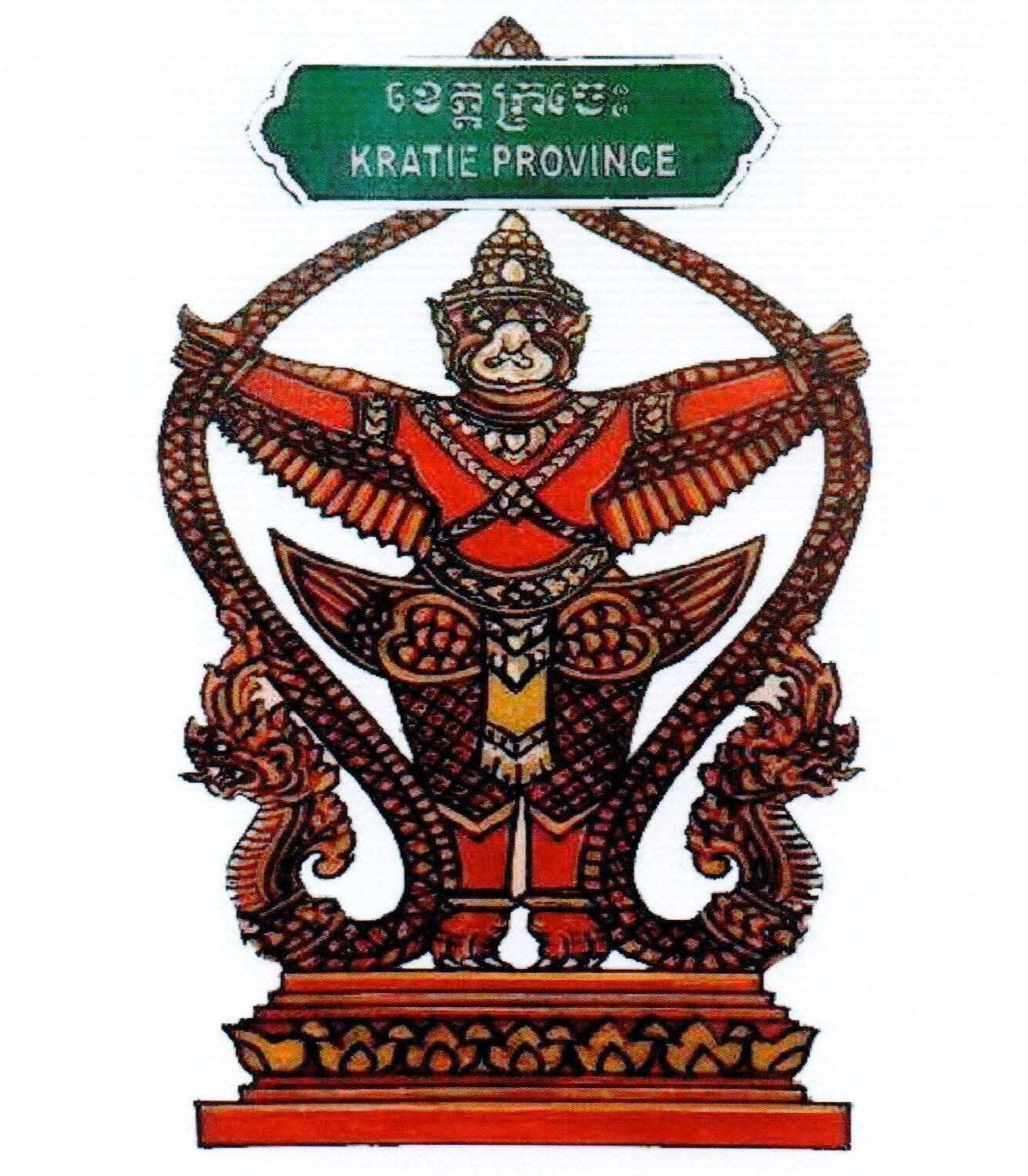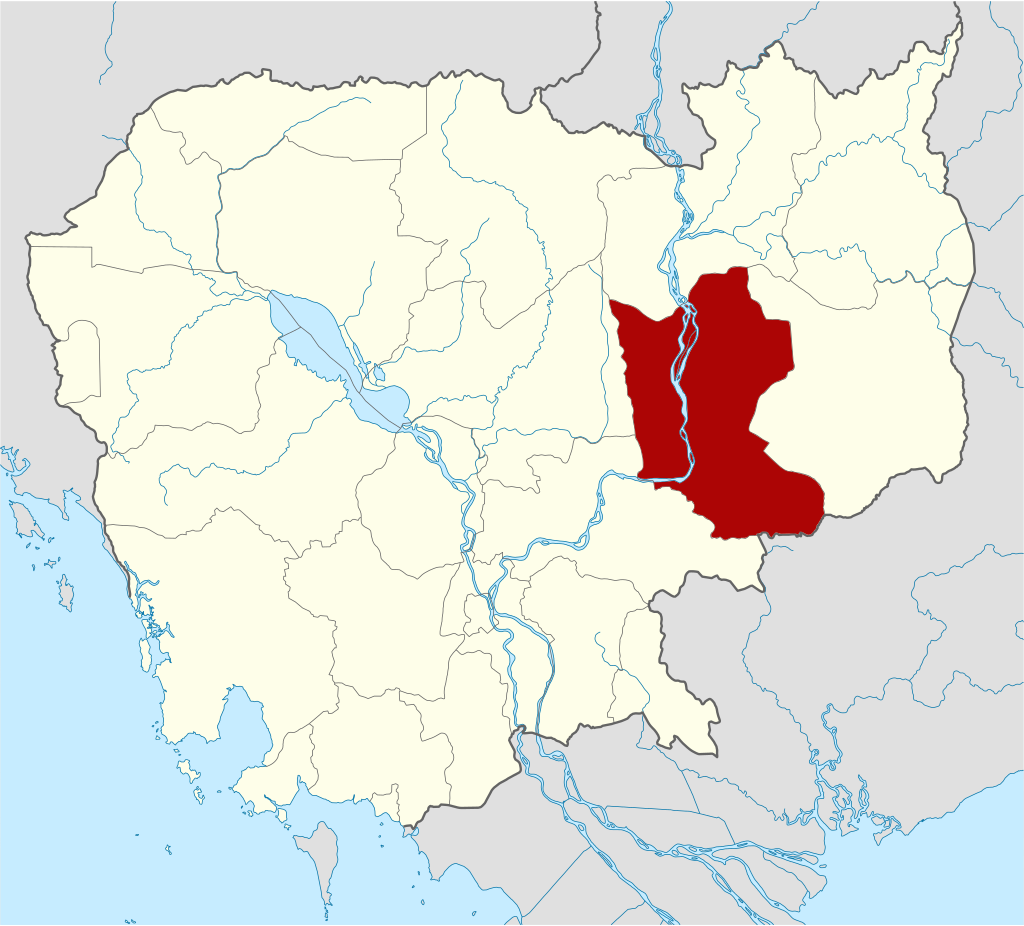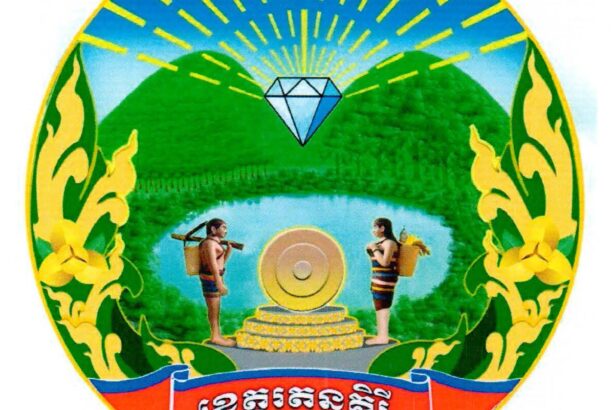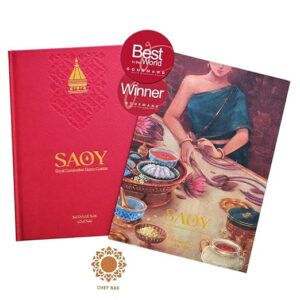Kratié province is a province of Cambodian located in the northeast along the Upper Mekong River which is 340 kilometers and 250 kilometers from Phnom Penh along National Road 7 and 73, respectively. Covering 11,094 square kilometers, it is bordered with Stung Treng to the north, Mondulkiri to the east, Kampong Thom and Kampong Cham to the west, and Tboung Khmum and the country of Vietnam to the south.
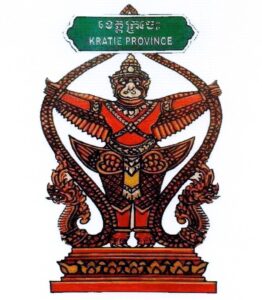
Kratié Province is a province in the northeastern highlands of Cambodia, a land famous for its delicious cakes and a province that leaves a lot of ancient French art after Phnom Penh, Kampot and Battambang. Located in the highlands, Kratié Province is rich in forests, wildlife, and the Upper Mekong River, which is the source of water for fish habitats, and in particular, the Mekong River has deep canyons that are home to fish and dolphins, and this dolphin A rare aquatic species.
The area of Kratié Province was the former capital of Sambopura during the Chenla period (Second Kingdom), where the capital was located in Sambo district. Moreover, the province also has some ancient temples built in the 8th century, such as Neang Pov temple in Sambok commune, Preah Theat Khwan II temple in Kratié district, Toul Trapeang Thmor temple in Sambo district, located to the east of Pram temple and Koh Kring temple that have beautiful deities and ancient halls. The Hundred Pillars Temple, built in the 16th century, is associated with Khmer legends Kraper Nen Thon, Ancient Khmer houses, French-style buildings, and many other unnamed temples that have been demolished. In addition to the temples, there are inscriptions of the Khmer ancestors that remain to this day, proving that Kratié has a rich cultural or historical heritage for national and international scholars to explore more.
Many places in Cambodia have different names depending on the history of the area, however, the naming of Kratié province also has an interesting history. To know exactly where, when and which period of the name of Kratié province comes from?
Kratié is the French spelling derived from the Khmer Krâchéh. According to the Khmer dictionary, the word “Kratié” is explained as the name of a province of Cambodia. Kratié is the name of a kind of fragrant powder: Krâchéh powder. According to the Khmer dictionary of Samdech Preah Sangkhareach Chuon-Nath, he wrote ” Krâché (ក្រចេ)” is a term from Stieng people (an ethnic group of Cambodia and Vietnam. They speak Stieng, a language in the Bahnaric group of the Mon–Khmer languages). Krabei Kampong Krâché means Kampong Chamlorng Krabei (Buffalo Ferry Port), later became the word “Kratié”.
According to the elders living in Kratié province in the early 1900s, in the early days of Kratié province, many indigenous people lived and there were various trade contacts in the whole northeastern region. The “Buffalo Ferry Port” of the Stieng people passed from Kratié to the upper area and Kratié to the lower area and always came to exchange goods at this ferry. In a book on the history of Cambodia from the first century AD to the time of Adhémard Leclère, the former French Resident in Cambodia, published in Paris in 1914, there is an ancient city in Sambo district, Kratié province, called Sambopura. He explained: Sambhupura meaning city of scholars. Inscription evidence K.125 confirms that in Kratié province, there is an ancient Khmer city, Sambopura in Sambo district.
Kratié is divided into 6 administrative districts and 1 municipality, Kratié City. The province has one international border gates, called Trapean Sre checkpoint in Snoul district; one bilateral checkpoint called Chey Khlaing in Snoul district; and one regional checkpoint called O’ Leav in Snoul district. With over 440,000 people, the province is Cambodia’s seventh largest area and sixteenth populous. Kratie is a significant province historically, where many colonial structures, artifacts, and prehistoric settlements have been discovered.
History
Pre-History or Early History Period
Kratié has evidence of prehistoric human settlement, with archaeological findings such as tools and pottery. According to sources compiled by the Kratié provincial administration, the background of Kratié province, French researchers have confirmed that there is evidence more than 600,000 years ago of the first people living in Cambodia at the highlands area like Sre Sbov region, Rolouch, Sre Roeuseey etc. Until about the year 2500 BC, in the Snuol area of Kratié province, the first civil society states were built, living in a round-shaped camp at Thoun Snuol, Kamlek, Pak Kali, Cheung Khlo and Trapeang Leak Archaeology sites.
The region was part of the early Khmer civilization, which laid the foundations for the later Angkor Empire. It was part of the early first millennium Kingdom of Cambodia, called Funan. Later, Funan was superseded and captivated by Second Kingdom in the 6th century and the former Royal capital of Chenla era called Sambopura. Kratié features various temples established in the eighth century, such as Pram and Koh Kring, which have perfect deities and antique halls. The area around Kratié along the Mekong River was one of Cambodia’s most heavily populated regions prior to the Angkor Empire era.
During the height of the Angkor Empire (9th-15th centuries), Kratié was an important area due to its strategic location along the Mekong River. The province was part of the trade routes and served as a conduit for goods and cultural exchange between Angkor and other regions.
Post-Angkor Period
In addition, Kratié has the Vihear Sasar Muayroy Pagoda, which was built in the sixteenth century. This pagoda is associated with the Khmer tale Krapeur Nen Thun (Venerable Monk Thun, the Crocodile). After the decline of the Angkor Empire, Kratié, like much of Cambodia, experienced periods of instability and foreign influence, including invasions by neighboring kingdoms.
Colonial Period
In the 19th century, Kratié came under French colonial rule as part of French Indochina. The French established administrative structures, infrastructure, and rubber plantations in the region. Kratié Province during the reign of King Sisowath Monivong (1927-1941) was divided into the following districts and regions:
- Chao Vai Khet “ចៅហ្វាយខេត្ត” (Provincial Governor): Oknha Mahachonbat Ratha Rukhamaha Boront Kream Ream Senathipadei Serei Anurak Udomkrampahu “ឧកញ៉ាមហាជនបទរដ្ឋរុក្ខាមហាបុរន្តគ្រាមរាមសេនាធិបតីសិរីអនុរក្សឧត្ដមក្រមពាហុ”
- Phu Chuy Khet “ភូឈួយខេត្ត” (Vice Provincial Governor): Raksa Chunbot “រក្សាជនបទ”
- Ballat Khet “បាឡាត់ខេត្ត”: Bomrong Chunbot “បំរុងជនបទ”
- Chao Vai Srok Kratié “ចៅហ្វាយស្រុកក្រចេះ” (Governor of Kratié District): Chunbot Pheakdey “ជនបទភក្ដី”
- Chao Vai Srok Sambo “ចៅហ្វាយស្រុកសំបូណ៌” (Governor of Sambo District): Pbipheak Chan Kream “ពិភ័ក្ដិចន្ទគ្រាម”
- Chao Vai Snoul “ចៅហ្វាយស្រុកស្នួល” (Governor of Snoul District): Sena Pheakdey “សេនាភក្ដី”
- Chao Vai Srok Chhloung “ចៅហ្វាយស្រុកឆ្លូង” (Governor of Chhloung District): Sneha Nurak “ស្នេហានុរក្ស”
Marshal Lon Nol was a Cambodian politician and general who served as Prime Minister of Cambodia twice (1966–67; 1969–71), as well as serving repeatedly as defense minister and provincial governor of Kratié in 1945.
Independence and Conflict Period
Cambodia gained independence from France in 1953, and Kratié became part of the newly independent nation. During the Vietnam War and the Cambodian Civil Wars, as well as the later Vietnamese presence against the Khmer Rouge in Cambodia, Kratié, like many parts of Cambodia, suffered significant disruption, violence, and saw significant warfare. Operation Menu, a 1969-1970 US bombing campaign targeting Vietnamese supply routes and bases in Cambodia and Laos, culminated in a massive bombardment of Kratié.
The Khmer Rouge regime (1975-1979) had a devastating impact on Kratié, with forced evacuations, executions, and severe hardships for the local population. After the fall of the Khmer Rouge, the province began the slow process of recovery and rebuilding. Unexploded ordnance recovery and demining have been important initiatives since the mid-2000s.
Modern Day
Today, Kratié is known for its natural beauty, particularly the Mekong River and its population of Irrawaddy dolphins. The province is also noted for its historical sites, traditional Khmer culture, and growing eco-tourism industry.
Dignitaries who were former governors of Kratié since 1979
There were 7 Governors of Kratié Province from 1979-Present, including:
- Mr. Poun Ponleur (លោក ពូន ពន្លឺ) served as Chairman of Provincial People’s Revolutionary Committee from 1979-1982
- Mr. Thoeuk Kreoun Vutha (លោក ធឹក គ្រឿនវុត្ថា) served as Chairman of Provincial People’s Revolutionary Committee from 1982-1993
- H.E. Nou Phoeurng (ឯកឧត្តម នូ ភឿង) served as Provincial Governor from 1993-1998
- H.E. Loy Sophath (ឯកឧត្តម ឡូយ សុផាត) served as Provincial Governor from 1998-2004
- H.E. Kham Phoeurn (ឯកឧត្តម ខាំ ភឿន) served as Provincial Governor from 2004-2012
- H.E. Sar Chamrong (ឯកឧត្តម សរ ចំរុង) served as Provincial Governor from 2012-2018
- H.E. Va Thorn (ឯកឧត្តម វ៉ា ថន) served as Provincial Governor from 2018-Present
Geography
Kratié province is located in eastern Cambodia and is known for its diverse geographical features, primarily centered around the Mekong River. Here are some key aspects of its geography:
Topography: The province features a mix of lowland areas along the Mekong River and more elevated regions with hills and mostly covered in dense forests. Kratié’s forests are generally more open and less dense than those elsewhere in Cambodia, with deciduous trees that lose their leaves during the dry season. The landscape is generally flat to gently undulating, with the highest elevations found in the eastern part of the province. The Phnom Pram Poan Mountain range, Phnom Prech, and rubber plantations. Eastern Kratié is an important bird area. The fertile plains along the Mekong River are particularly suitable for rice cultivation and other crops. As result, agriculture is a major part of Kratié’s economy, with rice paddies, rubber plantations, and fruit orchards being common.
Water Bodies: The Mekong River runs through Kratié province from north to south with approximately 140 kilometers, playing a crucial role in the province’s ecosystem, economy, and transportation. Kratié’s fisheries are part of the Upper Mekong River Zone, which provides important habitat for migratory species and subsistence fishing but does not play a significant role in commercial fishing. The river is home to the endangered Irrawaddy dolphins, which attract tourists to the region.
Climate: Kratié has a tropical monsoon climate, characterized by a distinct wet season (May to October) and dry season (November to April). The wet season brings heavy rainfall, often leading to flooding in low-lying areas, while the dry season is marked by lower river levels and drier conditions.
Natural Resources, Vegetation and Land Use: The province contains significant forested areas, including deciduous and evergreen forests. These forests are home to diverse wildlife, including several endangered species. Numerous islands and sandbanks dot the Mekong River within Kratié, providing unique habitats and scenic spots for visitors. Some of these islands are inhabited and used for agricultural purposes. The seasonal flooding of the Mekong River creates extensive floodplains and wetlands, which are important for fish breeding and provide fertile grounds for agriculture. These areas are critical for the local fishing industry and rice production. Kratié includes several protected areas and wildlife sanctuaries aimed at conserving its natural habitats and biodiversity. Notable protected areas include the Kratié Protected Forest and the Mekong River dolphin conservation zones.
- Keo Sema Wildlife Sanctuary covered land area of 317,456 hectares sharing between Mondulkiri and Kratié provinces (in which 59,284 hectares are in Kratié Province)
- Prey Lang Wildlife Sanctuary covered land area of 489,663 hectares sharing between Kampong Thom, Stung Treng, Preah Vihear and Kratié provinces (in which 115,730 hectares are in Kratié Province)
- Sambo Wildlife Sanctuary covered land area of 82,506 hectares Prek Prasob Wildlife Sanctuary covered land area of 14,221 hectares
- Lomphat Wildlife Sanctuary covered land area of 356,087 hectares sharing between Ratanakiri, Mondulkiri, Stung Treng, and Kratié provinces (in which 6,112 hectares are in Kratié Province)
- Sor Sor Sdom Sat Tor Multiple Land Use covered area of 5,327 hectares.
Administrative divisions
As of 2024, the province is divided into 1 municipality (Krong) and 06 districts (Srok), 05 Sangkat and 42 communes (Khum), and 327 villages. Based on CDB of 2023, the total population is 444,266 people (female 223,370), the number of households is 103,673 households, and the density is 44 people/km2. Kratié municipality is the seat of government, commonly known Krong Kratié or Kratié City.
- Kratié Municipality (05 Sangkat)
- Chhloung District (08 Khum)
- Prek Prasab District (08 Khum)
- Sambour District (05 Khum)
- Snoul District (06 Khum)
- Chetr Borei District (10 Khum)
- O Kieng Sen Chey (05 Khum)
The provincial symbol is decaled by Ministry of Interior via a Prakas No.2040 BrK dated 7 May 2018 on the Establishment of Kratié Province Symbol. The symbol has shape, size and image as follow:
- The oval-shaped with the width equal to two-third of the length
- The Common Form: The Lotus shape represents the national identity and a country that respects Buddhism.
- The Garuda image represents the good instinct for governing the land, being brave, protecting nature and the wind.
- The Naga image represents the good instinct for prosperity, governing the Ganga Devi (Goddess of purification and forgiveness), Varuna God (Rain-God of Hinduism), and Agni God (Fire-God of Hindusim).
- The Throne image represents a national civilization in the style of Phnom Da, Frontal Lotus petal shape of Kbach Angkor.
- Facny Design represents the glorious Khmer culture.
- Gold color represents prosperity (Sovannaphum).
- Erath tone color represents solid rock elements.
- Green color represents the development.
Accessibility
- Road: The main road through Kratié is National Road 7 (340 kilometers) and 73 (250 kilometers) which starts in Phnom Penh.
- Waterway: there are 220 kilometers of waterway from Phnom Penh to Kratie.
- Airway: Kratié is an airport in the capital town of Kratié in Kratié Province, Cambodia. Its distance is about 3.5 kilometers from the town’s center. The airport’s land area is around 12.5 hectares. Its runway length is 1,180 meters at 30 meters wide on laterite surface. First opened as a military airfield in 1977, it was converted into civilian use in 2006. Nowadays, there is no service operation.
Tourism Products
Kratié province offers a variety of tourism resources, attracting visitors with its natural beauty, cultural heritage, and unique wildlife. Here are some of the main tourism highlights:
Wat Sasar Muayroy or 100 Columns Pagoda (វត្តសសរមួយរយ): Located in Sambor village, Sambor commune of Sambor district, it is a historical and religious site. The original pagoda was built in the 16th century and was made of wood with 116 pillars; unfortunately, it did not survive during the Khmer Rouge regime, though later on local people used it as a holy site. The entire pagoda was almost completely destroyed, and the main pagoda where tourists can learn about the history was built in the 21st century, made of cement and concrete. Only two of the original pillars survived and are now kept in the new building. According to legend, the pagoda is dedicated to the power of 100 Columns Pagoda and to maintain the soul of Preah Neag Varakak, the King’s daughter who was eaten by a crocodile named Nen Thun. The most special things about this pagoda are the large pagoda with 100 Columns and the statues of the crocodile named Nen Thun. This pagoda faces to the west, toward the Mekong River.
100 Pillar House (ផ្ទះសសរមួយរយ): This more than 200 years old house is located in Kandol village, Chhloung commune of Chhloung district. It is a Khmer-style wooden house which once had 100 pillars. There are only 56 pillars remaining because during Khmer Rouge period, 44 pillars were damaged. This ancient house was demolished on June 21, 2020 from its original location and rebuilt in the western part of the ancient temple of Wat Rokar Kandal, Kratié City, and was completed on April 12, 2021. Today, the house attracts tourists to visit, take photos and learn about the history of this house.
O Krasang Temple (ប្រាសាទអូរក្រសាំង) was a former Royal capital, Sambopura, during the Chenla Era. Nowadays, the temple is located in O Krasang village, Boeng Char commune, Sambor district of Kratié province. Unfortunately, some parts of the buildings are falling apart. The buildings were built dedicated to the Hindu god Shiva. Inside the temple, there are Shiva lingams and water flows from the cliff. The discovery of this temple was very important for historical researchers.
Pram Temple (ប្រាសាទប្រាំ): Located in Sarng village, Changrorng commune of Chetr Borei district, it is historical destinations, and it was built in the Chenla Era (686 CE). There was an inscription found in the area of Pram temple, called Inscription of Prasat Pram, kratie Province K.1431b (សិលាចារឹកប្រាសាទប្រាំ ខេត្តក្រចេះ k.1431ខ).
Old Rokar Kandal Pagoda (វត្តរកាកណ្តាល): Located in Rokar Kandal Mouy V is the cultural and religious monument which is more than 200 years old and is the oldest surviving monastery. In 2001, the monastery was restored with help from the Craft Alliance of Germany and opened for tourists to visit as well as to buy souvenirs, which are made of talipot palm leaf and rattan by the local community. However, this practice was discontinued. Beside the ancient style, the pagoda has several beautiful paintings inside the main building and wood carvings as well.
Sambok Mountain (ភ្នំសំបុក): This historical and cultural resort is a small hill about 70m high, located in Thmor Kre commune, Chetr Borey district, 10 km along Provincial Road 377 to Stung Treng. On the top of Sambok Mountain, there is a monastery for Buddhists to worship, and visitors can get there by climbing staircases with statues of Buddha and monks on the right side. This hilltop temple provides panoramic views of the surrounding countryside. It is an important pilgrimage site and features a series of statues and shrines, along with a forested area for hiking. This mountain is a meditation center as well.
Soporkaley Mountain (ភ្នំសុពណ៌កាឡី): Located in Chrouy Thma village, Chambak commune, Prek Prasab district, it is a natural resort which is a tourism site and attracts many visitors. It is also regarded as historical site named after a dead crocodile who died fighting Nen Tum (a famous fighter). It has 800 steps. On the top of the mountain, there is an old pagoda, monk’s quarters, a monastery and an almshouse. Visitors at the top can see the view of rice fields, farmland and the Mekong River.
Boeng Koh Sokram Natural Resort (បឹងកោះសុក្រម): Located in Dar commune of Chetr Borey district, Sokram lake is a natural tourism site which has tourism potential due to the scenery of a large lake, with clear, transparent water, a safe swimming area, a wooden bridge for tourists to sightsee around the lakefront, and beautiful plants along the shore There are picnic huts for tourists to enjoy their meals.
Irrawaddy Dolphins: The endangered Irrawaddy dolphins are a major draw for tourists. Boat tours on the Mekong River provide opportunities to see these rare animals in their natural habitat, especially near Kampi village.
Kampi Rapids (ទឹកធ្លាក់កាំពី): A popular spot for locals and tourists, the rapids are especially beautiful during the dry season when the water levels are lower, where the water flows along the rows of trees at the bank of the river. Located in the middle of the Mekong River with a beautiful sandy island, the Kampi Rapid is the most attractive site in Kratié province. That provide a picturesque location for picnics and relaxation. Domestic and international tourists often visit for swimming and enjoy a variety of dishes prepared by the local community.
Prek Kampi Village: Known for its traditional wooden houses and fishing culture, Prek Kampi Village offers an authentic Cambodian experience. Visitors can learn about local fishing techniques and enjoy fresh river fish.
Chhlong: A charming riverside town with well-preserved French colonial architecture. Chhlong provides a glimpse into Cambodia’s colonial past and has several old mansions and buildings worth exploring.
Koh Bromachary Community Based Tourism (សហគមន៍អេកូទេសចរណ៍កោះព្រហ្មចារី) is located in the middle of the Mekong River, with a beautiful landscape and large trees growing on the island. Koh Bromachary is surrounded by white sandy beaches and flooded forests, which is home to spawning fish. Trees along the riverbank also provide shelter to all kinds of birds, and the clear river water is great for swimming. A group of small islands near Koh Bromachary also creates a spectacular sight. It is situated in Chrouy Banteay village, Chrouy Banteay commune of Prek Prasab district.
Koh Pdao Community Based Ecotourism (សហគមន៍អេកូទេសចរណ៍កោះផ្តៅ) is an island on the Mekong River which has a green landscape and white sand, where tourists can watch river dolphins. Tourists can travel along the Mekong River from Kracheh to Koh Pdao to learn about the livelihood of the local people on Koh Pdao. It is situated in Koh Pdao village, Kampong Cham commune of Sambour district.
Koh Samseb Community Based Ecotourism (សហគមន៍អេកូទេសចរណ៍កោះសាមសិប) is an island with ecotourism potential that often attracts tourists to visit. Koh Samseb is a paradise with its beautiful nature, full of different kinds of birds and even endangered birds. Tourists can camp on beautiful white sandy beaches of the island. It is situated in Pon Ta Chea village, Ou Krieng commune, Sambour district.
Koh Trong Community Based Tourism or Koh Trong Island (សហគមន៍ទេសចរណ៍កោះទ្រុង) is a natural tourism site. A peaceful island in the Mekong River, Koh Trong offers a glimpse into rural Cambodian life include experiencing the livelihood of the local people and enjoying a variety of local crops, including the country’s most delicious “pomelo” fruits. Additionally, in the season with low tide, Koh Trong is surrounded by beautiful sandy beaches that are suitable for tourists to walk and enjoy swimming in the Mekong River. Visitors can explore the island by bicycle or ox-cart, enjoy traditional farming scenery, and experience local homestays.
The tourism industry in Kratié has grown significantly over the years, transforming the province into a popular destination for both domestic and international travelers. Here’s an overview of the key aspects of Kratié ‘s tourism industry:
Accommodations: 15 Hotels (equally 622 rooms) and 52 Guesthouses (equally 513 rooms) offer service ranging from budget to mid-range options, accommodations are available in Kratié town and near popular tourist sites. Moreover, Homestays is also available, allowing tourists to stay with local families provides an immersive cultural experience and supports the local economy.
Restaurants and Eateries: Local Restaurants and Cafés offer a variety of Cambodian dishes, including regional specialties. Moreover, Street Food offers an authentic way to experience local cuisine, with vendors selling snacks and meals at markets and along the streets. There are 155 restaurants and eateries (equally to 1,322 chairs).
Transportation Services: Local transportation options, including auto-rickshaw and manual-rickshaw and Moto-taxis, are common and affordable modes of transport for short distances and local travel. Moreover, Car and Bike Rentals are also available for those who prefer to explore the province at their own pace. Additionally, regular bus services connect Kratié to major cities like Phnom Penh and nearby regions.
Other Activities:
- Markets and Local Crafts: The provincial capital, Kratié town, has lively markets where visitors can buy local produce, handicrafts, and souvenirs. Traditional weaving and pottery are among the local crafts on offer.
- Community-Based Tourism: Several community-based tourism projects in Kratié allow visitors to stay with local families, participate in daily activities, and learn about Cambodian rural life and culture. Kratié is developing its eco-tourism potential, with initiatives aimed at preserving the environment and supporting local communities. Activities include forest trekking, bird watching, and visits to wildlife sanctuaries.
- Mekong River Cruises: Cruises along the Mekong River offer scenic views of the river, its islands, and surrounding landscapes. These cruises often include stops at local villages and historical sites.
Gallery

